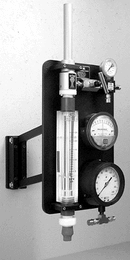TN-Steve
Contributor
I'm rather pleased with myself. I started off with a Dive Rite 1208 First and a 2015 balanced adjustable second stage I got off of ebay. (supposedly had been serviced and was in good condition).
I think that the seller was a bit "optimistic" regarding their condition.
The 1208 blew past 180 psi intermediate pressure on the test bench before I managed to shut off the air supply. And I don't mean it was slowly drifting, that needle was still screaming.
The second stage, when attached to a good first, just wouldn't seal.
Figured I had my hands full, but armed with a couple of rebuild kits and the manuals I took to it.
The first was so corroded at the ambient end that I had to use PB Blaster and let it sit for 48 hours to take it apart. The spring was absolutely caked with white stuff.
Everything got ultrasonic cleaning in hot soapy water, good toothbrushing, then rinsed, and then any parts that really needed it got 3 minutes in the cleaner in a vinegar solution, and the same treatment. Rinse and dry.
Took me a lot longer to get it apart than to put it back together. (I made sure to take plenty of pics and taped o-rings to a piece of cardboard so I could correctly identify the right one come reassembly.
End of the day, I've got a reg that's holding 140 IP like a champ, that is cracking at 1 inch, (wish I could get it lower, but I'm happy with that), and on the flow meter with the lever in dive mode is sitting about 1.1 inches all the way up to 12.5 SCFM.
All in all, it was easier than I had expected, and considering what I started with, I'm pretty well pleased. I'll mate it up with one of my 1215 octos (Haven't rebuilt them yet, waiting on the kits to come in, but they work fine already) and dive it this coming weekend for my Rescue Diver class.
Looking forward to getting lots of good info here as I continue my trek toward "Equipment Repair Guy"
Steve
I think that the seller was a bit "optimistic" regarding their condition.

The 1208 blew past 180 psi intermediate pressure on the test bench before I managed to shut off the air supply. And I don't mean it was slowly drifting, that needle was still screaming.
The second stage, when attached to a good first, just wouldn't seal.
Figured I had my hands full, but armed with a couple of rebuild kits and the manuals I took to it.
The first was so corroded at the ambient end that I had to use PB Blaster and let it sit for 48 hours to take it apart. The spring was absolutely caked with white stuff.
Everything got ultrasonic cleaning in hot soapy water, good toothbrushing, then rinsed, and then any parts that really needed it got 3 minutes in the cleaner in a vinegar solution, and the same treatment. Rinse and dry.
Took me a lot longer to get it apart than to put it back together. (I made sure to take plenty of pics and taped o-rings to a piece of cardboard so I could correctly identify the right one come reassembly.
End of the day, I've got a reg that's holding 140 IP like a champ, that is cracking at 1 inch, (wish I could get it lower, but I'm happy with that), and on the flow meter with the lever in dive mode is sitting about 1.1 inches all the way up to 12.5 SCFM.
All in all, it was easier than I had expected, and considering what I started with, I'm pretty well pleased. I'll mate it up with one of my 1215 octos (Haven't rebuilt them yet, waiting on the kits to come in, but they work fine already) and dive it this coming weekend for my Rescue Diver class.
Looking forward to getting lots of good info here as I continue my trek toward "Equipment Repair Guy"
Steve





